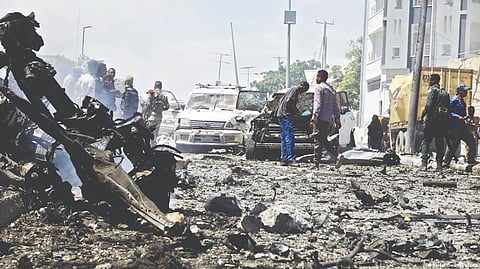

By JAN D. WALTER
WASHINGTON: A so-called “dirty bomb” is part of Russia’s latest blow in a global propaganda battle. Russian Defense Minister Sergei Shoigu has claimed Ukraine wants to deploy one, saying Kyiv plans a false flag operation aimed at discrediting Russia’s armed forces and leadership.
Ukrainian President Volodymyr Zelenskyy and several Western governments have dismissed the accusation. In fact, Zelenskyy thinks Moscow itself intends to use dirty bombs.
But what are they? Dirty bombs are conventional explosive weapons containing radioactive material, the kind that might be used for ordinary medical radiotherapy, in food conservation or in industry.
A dirty bomb is “not a nuclear bomb,” said Wolfgang Richter, a retired officer and expert on security at the German Institute for International and Security Affairs, or SWP. “This means there are no nuclear chain reactions, which unleash tremendous explosive force,” he added.
Nuclear weapons generate deadly heat and waves of pressure as well as extremely dangerous radiation, which spreads over vast areas through wind and rain. Dirty bombs don’t do most of that.
In fact, dirty bombs are most dangerous during their initial explosion, Richter said. However in the long run, the radiation emitted can prove hazardous or even lethal, depending on the dosage.
The size of the detonation and strength of radiation determines how much territory may be contaminated and even perhaps rendered temporarily uninhabitable. Dirty bombs are not new.
Until now, many considered them to be a weapon that mostly terrorists might deploy. In 2003, police seized illegal deliveries of radioactive caesium and strontium in Tbilisi and Bangkok. Both substances could have been used to build dirty car bombs.
Such a bomb, detonated in a densely populated area, would have required a large-scale evacuation and costly clean up, another SWP expert, Gebhard Geiger, said at the time.
In September 2016, on the 15th anniversary of the 9/11 attacks, US lawyer and journalist Steven Brill published an article in The Atlantic asking whether America had become any safer since the New York bombings.
He wrote that in 2013 and 2014, radioactive material had been reported lost or stolen 325 times. The real figure, including cases that went undetected or were covered up, could be even higher and Brill accused US politicians of not paying enough attention to this threat.
According to Brill’s research, a dirty bomb detonated by terrorists in central Washington D.C. could contaminate 40 city blocks and require billions to be spent on nuclear decontamination.
Yet even without any evacuation, experts estimated that no more than about 50 people would die following such an attack, Brill wrote — a “casualty rate that could probably be offset by an anti-smoking campaign in one or two D.C. office buildings.”
But while the casualty and death toll may be limited, dirty bombs could spark considerable panic. That’s why politicians should work to dispel this fear, Brill argued.
A military-grade dirty bomb could be far more destructive than one made by terrorists though. “You can imagine this being like the radiation emitted during an accident at a nuclear power plant,” SWP expert Richter told DW. “Chernobyl would be an example.” In 1986, one of the reactors at Ukraine’s Chernobyl power plant suffered a meltdown.
A 30-kilometer exclusion zone has been in place around the site of the accident since then.
Richter thinks it unlikely that Russia would use a dirty bomb though. It would run counter to its major mobilisation effort, he said.
Visit news.dtnext.in to explore our interactive epaper!
Download the DT Next app for more exciting features!
Click here for iOS
Click here for Android